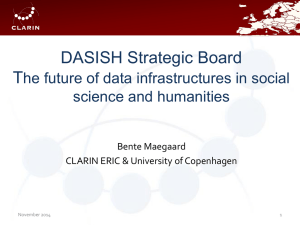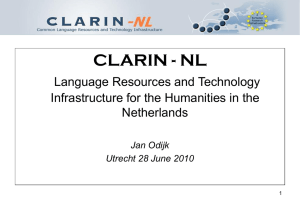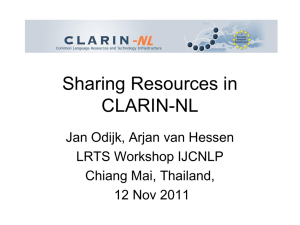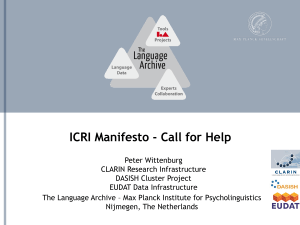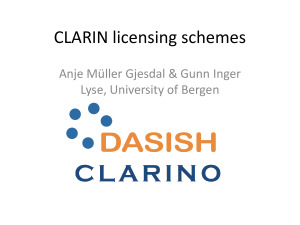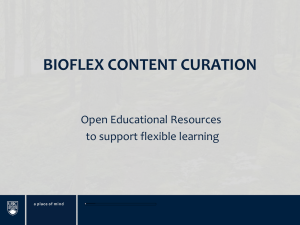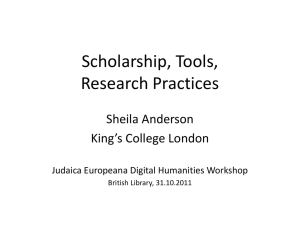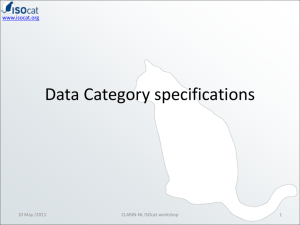The CLARIN-NL Project
advertisement
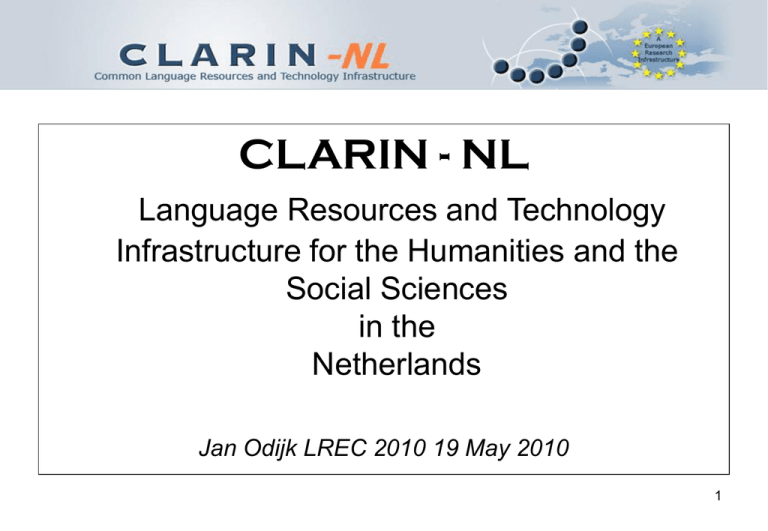
CLARIN - NL Language Resources and Technology Infrastructure for the Humanities and the Social Sciences in the Netherlands Jan Odijk LREC 2010 19 May 2010 1 Overview • • • • • • • The CLARIN-NL Project CLARIN Infrastructure Targeted Users Subprojects Relation with CLARIN-EU Future Conclusions 2 CLARIN-NL Project • Project in the Netherlands • Aims to play a leading role in the creation of the European CLARIN technical infrastructure • Budget: 9.01M Euro • 2009-2014 • Coordinated by Utrecht University • 23 participants • http://www.clarin.nl/ 3 CLARIN-NL: Infrastructure • The CLARIN Infrastructure – Will make data and tools on different locations easily accessible via web interfaces and services (CLARIN-portal(s) with intelligent searching, browsing, viewing and querying services) – Will make it possible for non-technical researchers to extract / combine/ enrich data (supported by dissemination and training) – Will make available interoperable data and tools based on existing standards and best practices 4 CLARIN-NL: For whom? • For researchers that work with language data – Humanities • • • • • • Linguistics (broadly construed) Literary and Theatrical Studies Media en Culture History Political Sciences … 5 CLARIN-NL: For whom? • Current Partners (23) – Targeted Users • • • • • Linguistics (10) Culture (2) Lexicography (2) Social History (4) Literature (2) – Technology Providers • Language technology (6) • Speech technology (2) – Data Centres and Service providers • Data Centres (5) • Libraries (2) 6 CLARIN-NL: Subprojects • Infrastructure Implementation – General • Partners: Candidate CLARIN Centres – MPI, MI, INL, DANS • Directly assigned subprojects • Provide guidelines / training for others – Metadata project (.5 yr) • Testing CMDI against existing national data • Create initial set of required metadata components 7 CLARIN-NL: Subprojects • Infrastructure Implementation (cont.) – Infrastructure Implementation (3 yrs) • infrastructure services, an open archiving service, registries, federation of centres, set up a schema registry, profile matching, ISOCAT maintenance, add relation registry RELCAT. • coordinate and give guidance for work on web services, wrapper and service bus specification and implementation, select work flow tools and experiment with them. – Search&Develop (3 yrs) • centralized metadata search • distributed content search – Text based and structured search 8 CLARIN-NL: Subprojects • User Survey & Base Line (.5yr) – Directly assigned subproject – User survey • Interactive interviews – Current use/non-use of digital data and tools • Identify causes for non-use • Identify obstacles for (wider) use 9 CLARIN-NL: Subprojects • Data Curation & Demonstrator Projects – Data Curation project • adapt existing resource making it visible, uniquely referable and accessible via the web, and properly documented – Demonstrator projects • Create a documented web application – that can be used as a demonstrator – starting from an existing tool or application – that can function as a showcase of functionality CLARIN will support 10 CLARIN-NL: Subprojects • Data Curation & Demonstrator Projects – Common Goals • apply standards and best practices and make use of the suggested CLARIN architecture and agreements – esp. CMDI & ISOCAT – to understand their limitations and the requirements for extensions • establish requirements and desiderata for the CLARIN infrastructure. 11 CLARIN-NL: Subprojects • Data Curation & Demonstrator Projects – Must involve a targeted user and address the user’s research questions – Open call for subprojects – Small subprojects (.5 yr / 60k Euro) – 17 projects submitted, 11 received funding – Will make available • a range of curated resources • a range of showcases of CLARIN functionality • evidence-based requirements and desiderata – for the CLARIN infrastructure and – for supported standards and best practices 12 CLARIN-NL: Subprojects • CKCC – Circulation of Knowledge and Learned Practices in the 17th-century Dutch Republic, ‘Geleerdenbrievenproject’ – Independently funded project (NWO) • Investigates how knowledge circulated in the 17th century • using a corpus of 20,000 letters of scientists from the 17th century in the Dutch Republic 13 CLARIN-NL: Subprojects • CKCC (3 yrs) – selected in the CLARIN-EU call for humanities and social sciences projects as the project proposal • that “[would] best demonstrate the use of LRT and would show the potential of a research infrastructure in the humanities” – Receives some CLARIN-NL funding for • Extending use of language technology • make adaptations to apply CLARIN-recommended standards and best practices 14 CLARIN-NL: Subprojects • Cooperation Netherlands – Flanders (3yrs) – Directly assigned • NL funding from CLARIN-NL • FL funding from EWI – – – – Large consortium of partners (10 NL / 7 FL) Focuses on the shared Dutch language Builds on results from STEVIN programme Core: adapt STEVIN tools to become web services that can be used in a work flow system – For Text and Speech – Targeted (and participating) users: researchers in literary studies, archaeology (text), and social history (speech) 15 CLARIN-NL: Subprojects • Education, Training & Awareness – Organize conferences / workshops / meetings – Attend / presentations at events – Support events (logistically and financially) – Support individual researchers for visiting events – Tutorials and lectures (ISOCAT, CMDI, PIDs, …), presence at Summer and Winterschools – Website (with Web2.0 functionality) – Newsflashes, newsletters, etc. 16 CLARIN-NL: v. CLARIN-EU • Organizationally – A CLARIN ERIC is being set up – NL aims to host the CLARIN ERIC – Dutch Minister of Education, Culture and Sciences invited his colleagues to join the CLARIN ERIC – CLARIN-NL has funds to fulfil a leading role of NL in the CLARIN ERIC 17 CLARIN-NL: v. CLARIN-EU • Content-wise – Complementary to EU preparatory project • Not only preparatory phase but also implementation phase and first part of exploitation phase • carries out activities such as the metadata project, the data curation and demonstrator projects – Focusing on data and tools from the Netherlands – Not covered by the European preparatory project 18 CLARIN-NL: Future • Working on priorities for next subprojects (2010-2011) – Analyzing current situation, identifying gaps – Proposals are being worked out on • form (open call, tender, direct assignment, mix) • focus on topics/disciplines • Budget and timing – Decisions expected Mid 2010 • Centres of Expertise – Centres of expertise are physical or virtual centres that possess a specific type of knowledge and expertise on a topic that is relevant to CLARIN and that have sufficient mass to guarantee the sustainability of this knowledge and expertise. – Identify candidates – Plan of activities 19 CLARIN-NL: Future • Embedding – start work for ensuring the longer term existence of the CLARIN infrastructure – embed it in the normal research activities – prepare both a governance structure and structural financing – in close cooperation with CLARIN EU • Continue and intensify educational, training and awareness activities – In particular get the CLARIN infrastructure and working in a CLARIN-compatible manner into the regular curricula of universities. 20 CLARIN-NL: Conclusions • the CLARIN-NL project is an excellent example for other national CLARIN projects – mix between a programme and a project • provides flexibility (new developments, new players) • offers opportunities for defining a few longer term projects in selected areas to sustain knowledge and expertise built up in the participating institutes. – data curation and demonstrator projects • offer opportunities for testing standards and best practices and CLARIN architecture • will strengthen these and also show their limitations • Will provide evidence-based arguments for modifications or extensions • Provides opportunities for influencing a selection of standards and best practices compatible with the existing national data. • will yield curated data, a range of showcases for explaining and demonstrating the advantages of the CLARIN infrastructure and the new possibilities it will offer 21 CLARIN-NL: Conclusions – Involvement of targeted users • cooperation between the targeted users and the technology providers is required • with a central role for the users' research questions • bringing these different communities together in concrete cooperation projects • So that the CLARIN infrastructure will provide the functionality that is actually needed by the researchers 22 CLARIN-NL Thanks for your attention! 23
